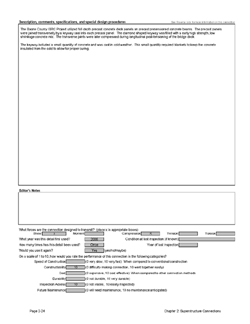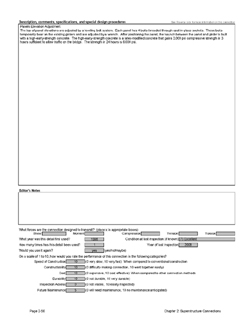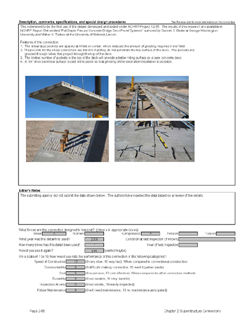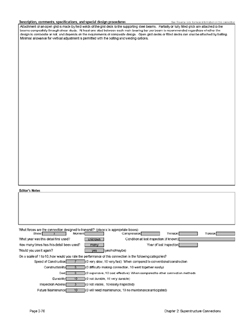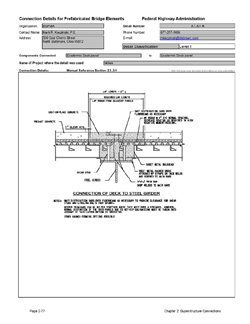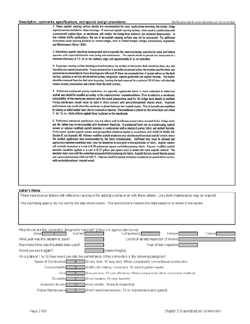| << Previous | Contents | Next >> |
Connection Details for PBES
Chapter 2 - Superstructure Connections
2.1.12 Connection Detail Data Sheets for Deck Systems
The following pages contain data sheets for various details used in prefabricated deck systems. This information was primarily gathered from agencies that have developed and used the systems. Some systems were obtained from manufacturers and industry groups. Most data in the sheets were provided by the owner agency; the authors added text when an agency did not supply all requested information. The owner agencies also provide a comparative classification rating.
Each connection detail data sheet is presented in a two-page format. Users of this Manual can simply remove and copy a data sheet for use in developing a system for a particular project. These sheets are meant to give users a basic understanding of each connection that can be used during the type study phase of a project. The data sheets are not meant to be comprehensive, but do convey the component make-up of the detail, how it is meant to function, and provide some background on its field application. Users will need to investigate each connection further, consider site-specific conditions, and apply sound engineering judgment during design.
The key information provided for each connection is as follows:
- Name of the organization that supplied the detail
- Contact person at the organization
- Detail Classification Level
- Level 1
This is the highest classification level that is generally assigned to connections that have either been used on multiple projects or have become standard practice by at least one owner agency. It typically represents details that are practical to build and will perform adequately. - Level 2
This classification is for details that have been used only once and were found to be practical to build and have performed adequately. - Level 3
This classification is for details that are either experimental or conceptual. Details are included in this Manual that have been researched in laboratories, but to the knowledge of the authors, have not been put into practical use on a bridge. Also included in this classification are conceptual details that have not been studied in the laboratory, but are thought to be practical and useful.
- Level 1
- Components connected
- Name of project where the detail was used
- Manual Reference Section
- The section(s) of this Manual applicable to the particular detail shown.
- Connection Details
- Description, comments, specifications and special design procedures
- Forces that the connection is designed to transmit
- Information on the use of the connection (including inspection ratings)
- A performance evaluation of the connection rated by the submitting agency
Click images below to enlarge
Detail 2.1.1.1A
Detail 2.1.1.1B
Detail 2.1.1.1C
Detail 2.1.1.1D
Detail 2.1.1.1E
Detail 2.1.1.1F
Detail 2.1.1.1G
Detail 2.1.1.1H
Detail 2.1.1.1I
Detail 2.1.1.1J
Detail 2.1.1.1K
Detail 2.1.1.2A
Detail 2.1.1.2B
Detail 2.1.1.2C
Detail 2.1.1.2D
Detail 2.1.1.2E
Detail 2.1.1.2F
Detail 2.1.1.2G
Detail 2.1.1.3A
Detail 2.1.1.3B
Detail 2.1.1.3C
Detail 2.1.1.3D
Detail 2.1.1.3E
Detail 2.1.1.3F
Detail 2.1.1.4A
Detail 2.1.1.4B
Detail 2.1.2.2A
Detail 2.1.3.1A
Detail 2.1.3.2A
Detail 2.1.3.2B
Detail 2.1.3.3A
Detail 2.1.4.1A
Detail 2.1.4.1B
Detail 2.1.4.2A
Detail 2.1.4.2B
Detail 2.1.4.2C
Detail 2.1.4.2D
Detail 2.1.4.3A
Detail 2.1.5.1A
Detail 2.1.5.2A
Detail 2.1.5.2B
Detail 2.1.5.2C
Detail 2.1.6.1A
Detail 2.1.6.2A
Detail 2.1.6.2B
Detail 2.1.6.2C
2.2 Adjacent Butted Beam Systems
Butted beam systems have been used for many years. These systems are often used for accelerated bridge construction projects to avoid deck forming and, in some instances, deck placement. Many states have standard details for butted systems, though only a few states have submitted details for this Manual. The following sections outline some of the more common systems in use.
Figure 2.2-1 shows typical span ranges for different butted beam systems. The span ranges can vary significantly depending on the specific state standards, but the general span ranges are shown for informational purposes.
Figure 2.2-1 Typical Span Ranges for Different Butted Beam Systems
(Click image to enlarge.)
Notes:
- This chart is for information purposes. It should not be construed to mean specific limits.
- Common span ranges are shown for the type of beams listed.
- Minimum spans shown are based on common bridges. Shorter spans can be used for all beams. For instance, a bulb tee bridge can be built to a 40 foot span, but this is not common.
- Maximum spans are approximate based on previous and current studies. The maximum span length will vary depending on many factors such as number of beams, size of parapets and sidewalks, concrete strengths, etc.
2.2.1 Precast Prestressed Concrete Deck Bulb Tee Systems
Many states have standard bulb tee beams. Bulb Tees are precast prestressed concrete I-shaped beams that have two common characteristics. First, the bottom flange is larger than on the older concrete I-beams, allowing for more strands to be placed in the bottom flange. Second, the top flange is approximately four feet wide. The combination of these two features improves the efficiency of the section. The top flange is relatively thin and does not act as a structural slab to support wheel loads. Typically a composite, cast-in-place concrete deck is placed over these beams.
The design and dimensions of bulb tees vary from state to state; however, several regions have agreed to use a common set of sections to facilitate fabrication across state lines.
Following development of precast prestressed concrete bulb tee beams, several states developed sections called deck bulb tees. The difference between these beams and normal bulb tee beams is that the top flange is intended to be the structural deck of the bridge. The top flanges can be as much as eight feet wide. The beams are connected in the field to form a beam/deck system.
When compared to adjacent prestressed box beams, deck bulb tee beams offer a system with improved inspection access and a simpler fabrication process. The undersides of the deck bulb tee beams are exposed for inspection unlike the inside of the most adjacent prestressed concrete box girders. There also are no void forms in bulb tees that need to be held in-place when placing the concrete.
2.2.1.1 Connections Between Beams
The states that use deck bulb tees use a welded tie connection combined with a grouted key. The ties are normally spaced five feet on center along the edge of the beam. This connection is primarily designed as a shear only connection. There is no intent to make this connection a deck moment connection; therefore each flange edge needs to be designed as a cantilever deck overhang.
Connections similar to this have been used in precast parking garage structures for years. There was concern that the welds would fatigue and break over time. The Texas DOT has researched transverse welded connections for adjacent precast members and found that when combined with a grouted shear key, the connection is sound and durable. The Texas research was completed for butted slab beams and double tees; however the results indicate that that the same connection may be viable for larger butted bulb tee systems.
The Washington State DOT detail is similar to details in Texas in that the weld is made in a beveled steel plate groove. This design allows the connection to be made even if there is slight camber differential between the beams.
There is ongoing research (unpublished at this time) on alternate grouted pocket connections between beams. Researchers are investigating the use of a small closure pour with headed reinforcing bars and even wire mesh projecting from the flange edges. This research has not been put into practice, but early testing has produced favorable results.
Some designers have concerns with the long term fatigue behavior of the welded tie connections. Therefore, at this time, it is recommended that these welded tie details be used for bridges with lower truck volumes.
2.2.1.2 Welding and Grouting Issues
Several issues need to be considered when using welded plate connections. First, the bottom portion of the welded plate connector is not protected from the weather on the underside of the connection. If a bridge is to be constructed in a corrosive environment, the designers may want to consider the use of stainless steel plates and rods. Second, it is important that the grout placed in the keys between the beams completely fills the void. The most common keyway failure results from inadequate filling of the keys. If voids are present, the mechanical interlock of the key is lost. Project specifications should require the use of durable, flowable grouts. Another successful method of placement requires minor rodding of the grout after placement. Leakage through grouted joints is a concern for many states. Even with the best grout, minor shrinkage cracking can be expected. For this reason, many states incorporate overlays and waterproofing systems for butted beam systems. If an exposed deck is desired, the cracks can be sealed during construction (see discussion in Section 2.1.7.2 for more information on this subject).
2.2.1.3 Camber Issues
Differential camber of the beams can lead to dimensional problems with the connections. The Texas and Washington DOT details can accommodate minor differential camber. If the differential camber is excessive, the contractors in some states will apply dead load to the high beam to bring it within the connection tolerance.
2.2.2 Precast Prestressed Concrete Tee Systems
Several different precast prestressed concrete tee systems are in use. Texas DOT has a modified deck slab beam with a tee flange extending beyond the sides of the slab as well as a double-tee section. Figure 2.2.2-1 depicts a typical cross section of the Texas decked slab beam with extended flanges. The Texas beams are connected using a welded anchor plate and grout. Other states have double-tees and even a tripletee. New York DOT built a quad tee system that was the full width of a two lane road.
Figure 2.2.2-1 Texas Decked Slab Beam with Flanges

These tee systems are very similar to the deck bulb tee sections described in Section 2.2.1 in that the top flanges of these sections are designed to be the structural deck of the bridge.
2.2.2.1 Connections Between Beams
The connections used for tee beams are essentially the same connection used for the deck bulb tees. See Section 2.2.1 for more information on this connection.
2.2.2.2 Span-to-Span Connections
New York DOT has used a beam end-to-end connection over the supports to provide span-to-span continuity. The negative moment reinforcing was connected using mild reinforcing bar couplers. The design was proposed as part of a value engineering proposal for a large viaduct on Long Island (Robert Moses Causeway). This project involved the use of full width precast superstructure sections (quadtee). The bridge is designed to act as a simple span for dead load, and as a continuous beam for live load. This concept is not new to the prestressed concrete industry. Prestressed concrete I girders are commonly made continuous for live load by using the cast-in-place concrete deck as a top flange tension connection. The New York detail makes use of the full width top flange of the quad tee to make a small closure pour across the bridge deck. The quad tee system included concrete end diaphragms cast into the pieces, which acted as forms for the small closure pour.
| << Previous | Contents | Next >> |



